Amazing colored potatoes: varieties and their beneficial properties
Many Russian breeders are developing new potato varieties with colored flesh. The multi-colored color of the potato pulp and skin is the result of the influence of natural pigment. The main advantage of colored potatoes is that they belong to dietary products.
However, not all gardeners like to experiment and are afraid to plant new crops. Therefore, we will consider in detail what the features of colored potatoes are, how they differ from ordinary ones and whether it is worth growing them.
Description of culture
Colored potatoes have a variety of flesh colors. This is due to the fact that the tubers contain pigments responsible for a certain color. They have nothing to do with GMOs; In addition, colored potatoes have many beneficial properties.
Reference. The brighter the color of the potato pulp, the more anthocyanins it contains, which are beneficial to human health.
Colored potatoes contain many antioxidants. The tubers of some red varieties have a ginger flavor. Purple varieties have a richer, sometimes nutty flavor.
The varieties with the most intense color are used for obtaining natural food coloring.
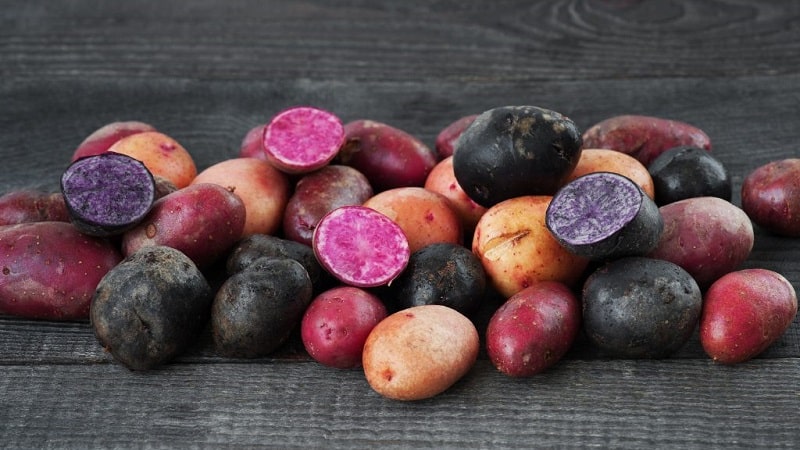
Origin and development
Colored potatoes have been known for a long time. Even before the revolution, in the famous company of the first Russian breeder E. Grachev, it was possible to purchase tubers with blue and red pulp.Russian breeders began growing similar potatoes in 2007. Currently, more than 10 groups of breeders are working in Russia to develop new varieties of such potatoes.
Varieties of colored potatoes
Breeders have developed many varieties of colored potatoes. The brightest representatives:
- All Blue – mid-late variety. The tubers have blue skin and bright purple flesh. To preserve color, potatoes are not allowed to boil. The variety has good taste.
- Boro – mid-season variety. The tubers have a bronze tint and blue flesh.
- Explosion (Explosion) is an early ripening variety with high yields. The color of the pulp is blue.
- All Red (All Red) lives up to its name, as the skin and flesh are a subtle red color. The taste is reminiscent of nuts.
- Cranberry Red (Red cranberry) – mid-early variety. The tubers are rich red in color, the flesh is pink with a reddish tint. The taste is aromatic and does not lose color when boiled.
- Vitelotte – a late-ripening variety with almost black skin and purple flesh. Has a sweetish nutty taste.
- Lilac – mid-season variety with purple flesh.
- Raspberries – a variety with red flesh and a pleasant taste. Retains color when cooked.
- Borodyansky pink – early ripening potatoes. The tubers are round, but uneven.
- Baron – early-ripening potatoes with yellow skin, reddish eyes and light cream flesh.
What determines the color of the pulp?
Colored potatoes contain plant glycosides - anthocyanins. These are natural pigments that are present in some plants in flowers, stems, leaves, roots, fruits and seeds: blue grapes, cranberries, blueberries, black currants, etc.
Attention! To ensure that the flesh retains its color when boiled, colored potatoes are not peeled, but boiled in their skins.
Chemical composition, trace elements and vitamins
Colored potatoes contain a high content of proteins, carbohydrates, vitamins, micro- and macroelements.
Vitamin content in 100 g of raw potatoes:
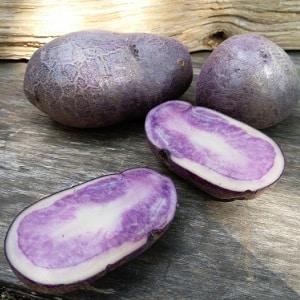 A - 2.9 mcg;
A - 2.9 mcg;- B1 - 0.14 mg;
- B2 - 0.63 mg;
- B5 - 0.35 mg;
- B6 - 0.34 mg;
- B9 - 0.75 mg;
- C - 21 mg;
- E - 0.11 mg;
- RR - 1.4 mg;
- beta-carotene - 0.02 mg.
Macronutrients:
- calcium - 11 mg;
- magnesium - 22 mg;
- sodium - 4.8 mg;
- potassium - 560 mg;
- phosphorus - 56 mg;
- sulfur - 31 mg;
- chlorine - 46 mg.
Microelements:
- iron - 0.91 mg;
- zinc - 0.31 mg;
- iodine - 5.1 mcg;
- copper - 136 mcg;
- manganese - 0.16 mg;
- fluorine - 27 mcg;
- boron - 116 mcg;
- aluminum - 850 mcg.
Calorie content - 78 kcal.
Nutritional value of 100 g of product:
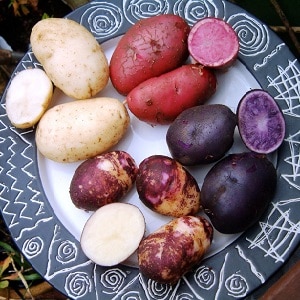 proteins - 2.3 g;
proteins - 2.3 g;- fats - 0.4 g;
- carbohydrates - 16 g;
- starch - 15 g;
- ash - 1 mg;
- water - 78 g;
- dietary fiber - 1.45 g;
- organic acids - 0.24 g.
Ripening period
Colored potatoes have different ripening periods, since among the variety of varieties there are early-ripening, mid-ripening, mid-late and late-ripening varieties.
Productivity
Since biologists are faced with the task of developing varieties of better quality, less attention is paid to increasing yields, therefore colored varieties of crops generally have average yields - 110-320 c/ha. But, for example, Ukrainian Red-fleshed and Purple Handsome are distinguished by high productivity.
Disease resistance
The main problem that arises when growing colored potatoes is low plant immunity.. Most varieties have average resistance to late blight. But, for example, the Exotic variety has good resistance to common crop diseases.
Characteristics of tubers and bushes
Bushes of multi-colored varieties of medium height, erect. The leaves are serrated, large, the flowers are medium-sized. The average weight of tubers is 90-120 g. The variety is characterized by an unusual taste, with a nutty flavor and notes of ginger.
Regions for cultivation and climate requirements
Multi-colored varieties grow well in all regions of Russia, but the best yield results were achieved in the Central, Volga-Vyatka, and southern regions of Russia. The exception is the northern regions of the country with short summers.
Advantages and disadvantages
Advantages of colored varieties:
- recognized as a dietary product;
- approved for diabetics;
- high content of antioxidants in tubers;
- the glycosides contained in tubers slow down the aging process of the body and prevent the spread of infections;
- anthocyanins in tubers block the formation of cancer cells;
- pleasant taste.
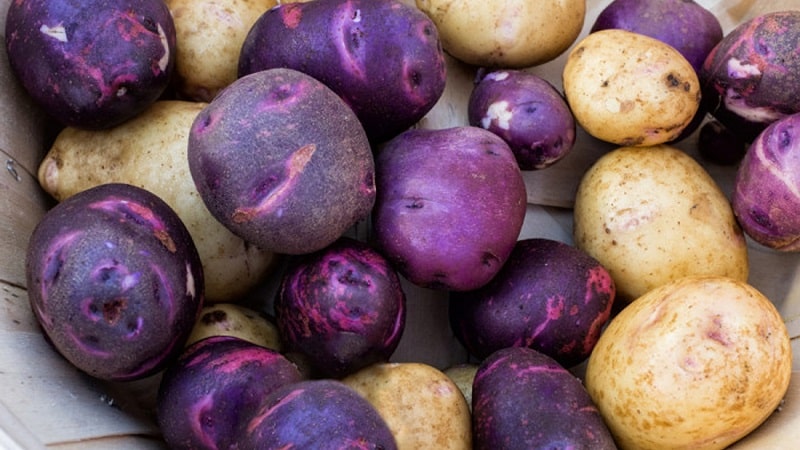
The disadvantages of multi-colored potatoes are::
- more complex cultivation compared to ordinary potatoes;
- long ripening period;
- average yields;
- low immunity;
- high price.
Difference from other varieties
Colored potatoes differ from ordinary varieties:
- varied color of pulp;
- eating potatoes does not affect blood sugar levels;
- less resistant to low temperatures;
- not grown on an industrial scale.
Benefits for the human body
Colored potatoes are famous not only for their unusual appearance, but also for their beneficial properties. carotenoids contained in tubers. It also contains plant glycosides (these substances color the pulp of mulberries, blueberries, and eggplant peel) - these are antioxidants that slow down the aging process of the body.And anthocyanins prevent the development of various infections and malignancies.
Features of planting and growing
Colored potato varieties are more demanding in terms of compliance with agricultural technology rules. The yield of these varieties depends on the composition of the soil - it must be fertile and breathable. The varieties do not tolerate high temperatures and lack of moisture.
Pre-sowing preparation
30-40 days before planting it is necessary to prepare seed material. To do this, healthy medium-sized tubers with developed eyes are selected and germinated in boxes, laid in two layers. Before germination, planting material is kept for 30 minutes in a solution of Fitosporin or boric acid (1 g per 10 liters of water) to prevent the occurrence of fungal infections during the growing season.
Important! Since colored varieties have average resistance to diseases, it is necessary to disinfect the tubers.
As soon as the sprouts on the tubers reach 1.5 cm, they begin planting in open ground.
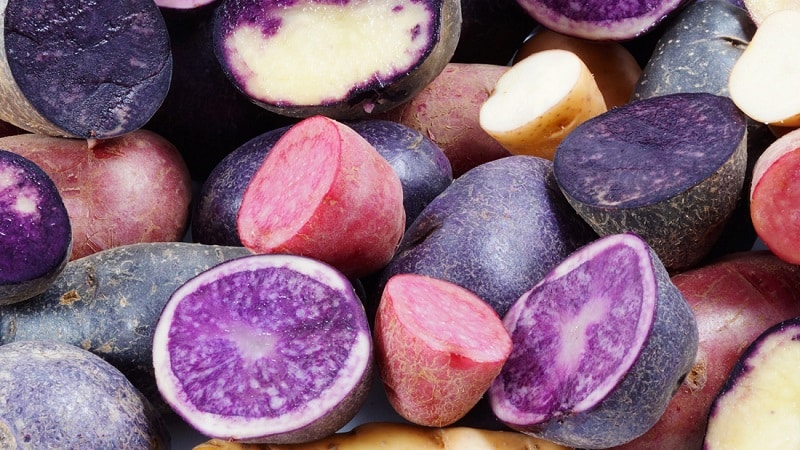
Soil requirements
Colored potatoes grow best on light, medium loamy, sandy loam, soddy-podzolic and chernozem soils. Much attention is paid to soil disinfection.
Dates, scheme and rules of planting
Prepared tubers are planted at the end of May, as soon as the top layer of soil 10-12 cm thick warms up to +10°C. Planting dates vary in different areas and depend on the onset of heat in the region.
For potato planting, a well-lit area is allocated. The soil is dug up in early May, adding charcoal and urea.
The holes are placed at a distance of 30 cm from each other. A distance of 65-70 cm is maintained between the beds.50 g of compost is poured into each hole 10 cm deep and the sprouted tubers are carefully placed without damaging the fragile sprouts. Sprinkle loose soil on top. When the temperature drops significantly at night, the beds are first covered with film.
Nuances of care
The soil for growing must be nutritious, therefore, in the fall, when digging deeply, for every 1 sq. m add 30 g of “Nitroammofoski” and 0.5 kg of humus or cow manure.
All weeds and plant debris are removed from the site.
It is recommended to plant colored varieties away from ordinary ones.so that cross-pollination does not occur.
Some colored varieties grow tall, powerful tops. These plants require constant hilling.
During the growing process it is necessary to monitor temperature changes. Higher or lower temperatures lead to lower yields.
Attention! Return frosts are especially dangerous for colored potatoes.
A drop in night temperature to -3°C has a detrimental effect on young seedlings.
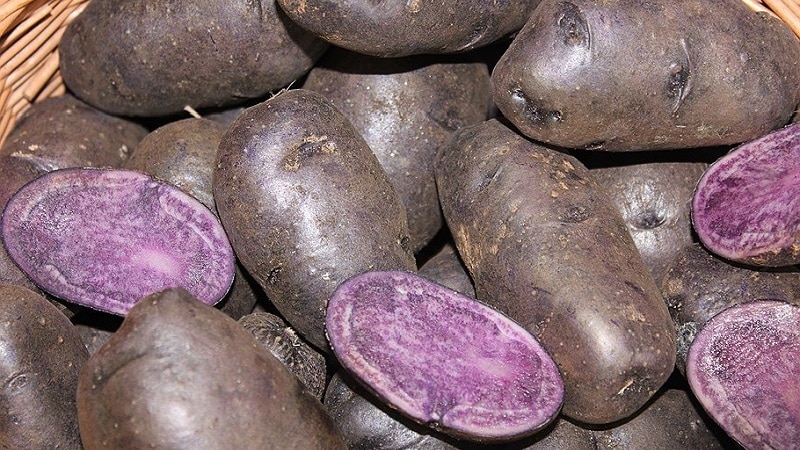
Watering mode
Potatoes of colored varieties are more moisture-loving compared to conventional varieties. For growth and development, it requires soil moisture of 70-75%.
First watering carried out when the seedlings reach 7-8 cm in height. Water with warm water in small portions, spending 1.5-2 liters of water for each plant.
Before flowering The bushes are watered every 7-8 days, depending on the dryness of the soil. Sandy soil is moistened more often than turf soil.
During flowering and tuber formation plants require more moisture. During this period, 8-10 liters of water are spent on each bush. Watering is carried out every 3 days in the morning or evening.
Reference. To prevent large amounts of water from washing away the tubers from the soil, it is advisable to carry out drip irrigation.
At the end of flowering the volume of liquid added is increased to 12-15 liters.
Last watering carried out when the lower leaves of the tops begin to dry out.
Top dressing
At the beginning of the growing season, nitrogen fertilizers are applied: 10 g ammonium nitrate and 10 g ammonium sulfate per 10 liters of water. Alternate with organic matter: 50 g of humus per 10 liters of water. At the beginning of flowering, superphosphate and ammonium nitrate are added at the rate of 20 g of each fertilizer per 10 liters of water.
After flowering ends, feed with a composition containing boron to improve the quality of tubers: 5 g of boric acid per 10 liters of water.
Weeding and hilling
During the entire growth of the crop, it is necessary to constantly remove weeds.. Weeds outpace potato bushes in growth and reduce the amount of nutrients in the soil. While weeding the beds, the soil is simultaneously loosened, providing air access to the roots.
When loosening the beds, the bushes are hilled, raking the soil up to the stems and creating a mound that helps maintain the tops in an upright position.
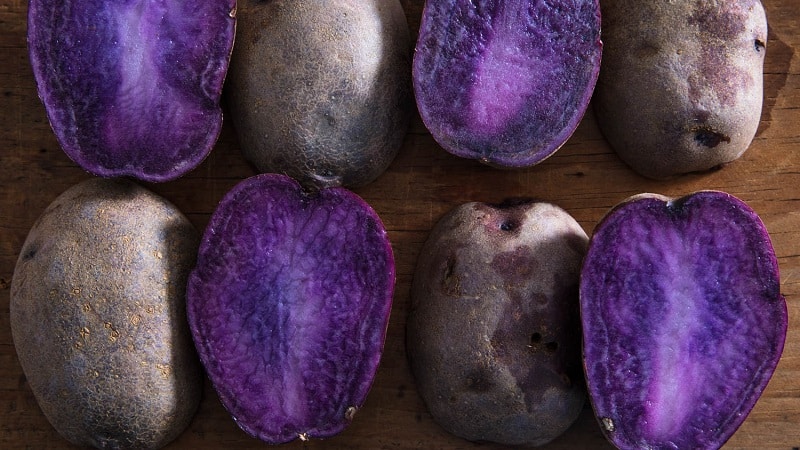
Disease and pest control
Colored potato varieties have low immunity to crop diseases. Most often potatoes affects late blight. The first sign of the disease is the appearance of dark spots on the tops. The disease quickly spreads to the tubers, and the process of rotting begins in them.
When the first signs of illness appear, apply composition of potassium permanganate, copper sulfate and boric acid, taken 5 g each and dissolved in 10 liters of water. The solution is sprayed onto the tops and poured under the root. If the lesion further spreads, the bushes are treated with the fungicides “Gamair” and “Oxyx”. The preparations are diluted at the rate of 15-20 ml per 10 liters of water and treated the soil around the plants.
Fusarium is a fungal disease of crops. A fungus appears in the stems, clogging the blood vessels and inhibiting the flow of juice. The tops turn yellow and wither. With fusarium blight, tubers stop growing. The affected bushes are treated with Trichoderma Veride at the rate of 50 ml per 10 liters of water.
Colored potatoes may be attacked Colorado potato beetle, feeding on all above-ground parts of the bush. To destroy it, insecticides “Iskra” and “Commander” are used: 2 ml of the drug is diluted in 10 liters of water for spraying the bushes.
Often appears in potato plantings wireworm, feeding on the pulp of tubers. To get rid of the pest, green manure is planted between the rows, and the soil is treated with Topaz fungicide: 2 ml per 10 liters of water.
Difficulties in growing
When growing colored varieties, you should considerthat they cannot tolerate late frosts, so when the temperature drops, covering material is used.
Many varieties have tall, spreading tops, so they require regular hilling to keep the bushes upright.
Harvest and storage
Different varieties of colored potatoes have different ripening times. Early ones begin to dig at the beginning of September, late ripening ones - at the end of September.
Harvesting is carried out in dry weather, since after rains the wet soil is difficult to dig and the tubers can be damaged.
The dug up potatoes are dried, spread out in one layer on a dry surface, sorted and stored.
How and when to collect
Potato harvesting begins after the tops turn yellow. The bushes are dug up with a pitchfork and removed from the ground, holding them by the tops. The tubers are shaken off the soil and sorted. Damaged ones are sent for processing, whole and healthy ones are laid out to dry in the shade.
Storage features and shelf life
Early ripening varieties are not suitable for long-term storage, so they immediately go to cooking. Late-ripening varieties, such as Vitalot and Ves Krasny, have good shelf life (95%) and are stored throughout the winter.
Attention! Potatoes of different shades should be stored in separate boxes.
A suitable microclimate is created in the vegetable storage with air temperature +3...+5°C, humidity 85-90% and constant air circulation. Under such conditions, multi-colored potatoes are stored 6-8 months.
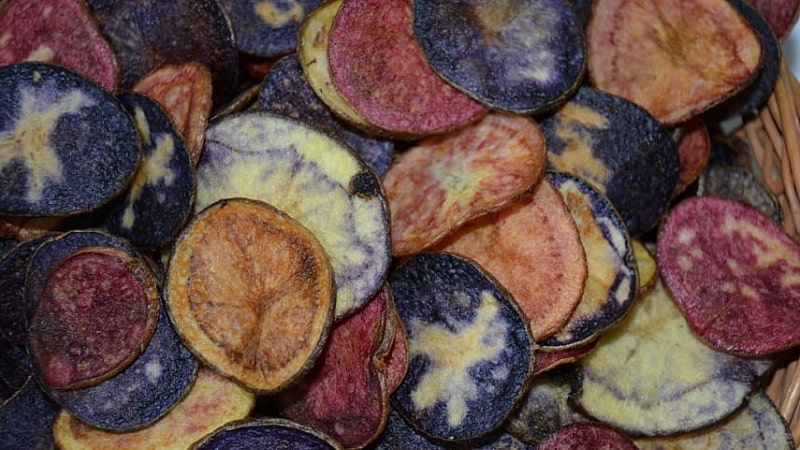
Advice from experienced gardeners
Gardeners, based on their own experience, have found that multi-colored tubers are not suitable for replanting, the harvest from last year's tubers will be smaller. For planting, it is better to purchase seeds at garden centers.
Purple varieties have tall tops with thick stemsTherefore, it is recommended to plant such potatoes at a large distance from each other, leaving at least 45-50 cm between the bushes.
To preserve the color of the pulp It is better to boil potatoes in salted water for no more than 20 minutes.
Reviews of varieties of colored potatoes
Reviews about colored potato varieties are mostly positive.
Olga, Yaroslavl: “I liked the characteristics and photos of the Favorite potato variety. I decided to try it, it turned out to be very tasty. It’s especially good for purees – it turns out just fluffy.”.
Victoria, Omsk: “I planted two varieties - Red Wonder and All Blue. The seed potatoes I bought turned out to be exactly the same as in the description. I didn't put much effort into growing it. I liked the harvest. The red tubers have a normal taste. All blue did not change color when frying, the taste is pleasant".
Natalya, Moscow: “I have been suffering from diabetes for a long time. I read the description of the Lord of Spaces potato variety.I learned from a friend that you can eat colored potatoes without restrictions. I tried to grow it on my own plot. Potatoes pleased me with the harvest. I really liked the taste of white potatoes with pink eyes.”.
Conclusion
Colored potatoes are becoming increasingly popular in many countries. Breeders are constantly improving taste and increasing the crop's immunity to diseases. The beneficial properties of colored varieties are well known. There is an increasing number of fans of unusual crop varieties among farmers.